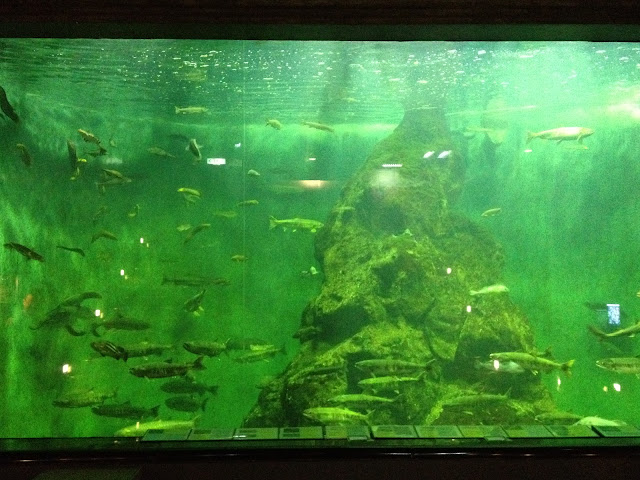This post is about one of the spots I visited this month during the JTB Monitor Tour course C to Shiretoko and Abashiri areas, Hokkaido.
If you are interested to read about the other spots,
please check this link:
JTB, well-known Japanese travel agency and one of the largest travel agencies in the world, conducted 7 kinds of 2-3 days guided tour packages to various places around Hokkaido for foreigners, and they are like almost free. Foreigners who wanted to participate had to apply and choose for a course depending on where and when they wanted to go. I was quite lucky to get a place ! ^^
The website of JTB Hokkaido is here (sorry, it seems everything is in Japanese).
We chose one of the furthest courses, Shiretoko and Abashiri. Shiretoko national park is a UNESCO world heritage, and Abashiri area is famous for its drift ice and old prison. I always want to go there but the timing was always not right. It's also very far, so beside the travel duration issue, it is quite costly to go there and also tiring for Javier if he has to drive alone.
According to the course information, the course included whale watching (!!!!! ), eating local foods, etc... yuhuuu! I always want to see the real whales, so I was so excited! However, we ended up not going for whale watching due to the bad weather.. :( I was sooooo disappointed! >____< Luckily there were tons of interesting spots to visit in Shiretoko area, so the trip generally was not bad. Ah.. the hotel we stayed at has public hot bath fully covered with jade! Amazing!
 |
| Gigantic aquarium with different kinds of salmon |
This time we visited Shibetsu Salmon Park in Shibetsu Town.
Shibetsu is a town located along Nemuro Strait in Eastern Hokkaido. Nemuro Strait itself lies between Hokkaido island and Kunashir island, which is an island controlled by Russia and claimed by Japan. Fishing and dairy farming are the main industries in this town.
The Salmon Park itself has the largest collection of Salmonidae, a family of fishes including salmon, trout, etc, in Japan. It is said that there are over 30 salmon varieties belonging to 18 species in this place. So many huh.. o.O I only knew red salmon and white salmon before, hehe. By the way, the white salmon is in fact not another species of salmon with white meat, to my surprise. A bit long to explain here, but if you are interested, you can try to check it online or maybe here.
In fact, not all of those salmon varieties are common in Japan. The most common ones found and widely consumed in Japan are chum salmon and masu salmon.
There were several medium-sized tanks which contain salt-water and freshwater, separating different species of salmon. On the other hand, at the area called stream plaza, there were several salmon species kept in different tanks depending on the nature of their habitats so we can observe the differences. Smaller tanks with aquarium look are also available for baby salmons from around 20 different species to let us observe the process of their growth. We also found a cute big turtle and some starfishes there.
 |
| Medium-sized tanks with salt-water and freshwater, separating different species of salmon |
 |
| A guide on how to cut a salmon |
There were a lot of activities we could do there also to understand more about salmon species and the life of several aquatic creatures. The one of the picture below, they had fishes which take away your dead skin. I suppose these fishes are the same fishes as those in spas, in which we can put our feet inside a pool full of these fishes for few minutes and let them take away our dead skin.
I tried this too but I couldn't stand the feeling! too ticklish for my standard! hehe. How to say.. it's not bad but you will feel something like having... small-but-continuous electric shock, maybe? I almost tried it in Singapore last time. Fiuh.... luckily I didn't. ^^ But honestly, don't stop yourself from trying it if you are not too sensitive of these kind of stuffs, hehe. It should be fun coz Javier loved it so much (it's his hand in the picture, by the way, while I prefer taking his picture to putting my hands in =P).
My other favourite activity (again, to watch only...) is this one:
.... which is ....
putting your finger(s) inside the mouth of these big-shark-look-alike fishes! O.o
Almost all of the participants tried, but I didn't. >___<
Check this video below! Javier was trying to put his fingers inside the biggest sturgeon's mouth! ^^ They called it "The boss", hehe, like in video games huh, so funny.
These fishes are called sturgeon, or チョウザメ(chousame) in japanese. I have no idea at all about this scary-looking fish. According to Wikipedia, sturgeon are native fishes from subtropical rivers, lakes and coastlines of Eurasia and North America.
I thought the sturgeons we saw at the park were big enough, especially since we also saw one of them which might be like 1.5m long (It was what they called "the boss"). However, in fact the length of sturgeons ranges from 2m to around 5m! o.O Caviar is made from sturgeon's roe, btw.
Another pic of sturgeons inside the pool. The picture is not that good but quite informative, I guess. Don't you think they somehow look like sharks? Creepy... but harmless, in fact.
 |
| Sturgeons roaming around the pool |
 |
| Young sturgeons |
It was a good idea to have some interactive activities in museums rather than just displaying samples and panels full of information, especially for children who tend to prefer trying something to reading the information, or for foreigners who can't read Japanese characters.







No comments:
Post a Comment